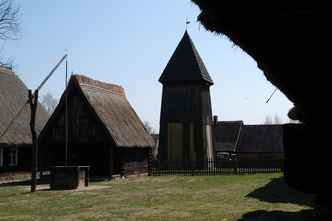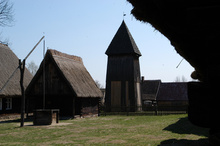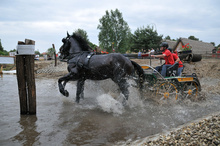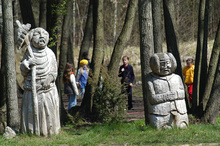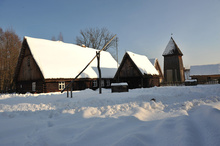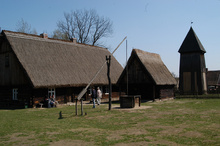Zielona Góra Commune
Zielona Góra County like a crescent roll surrounds the town of Zielona Góra from three sides. Forests constitute one third of its total area; therefore it offers perfect conditions for rest and relaxation in the open.
Years ago, the area was shaped by Skandinavian glaciation, which left behind interesting land relief in the form of the Zielona Góra Height with a more than 200-metre-long Wilkanowo Hill.
By the road from Kiełpin to Zatonie, there lies the 87.66-ha ‘Cold Water’ Reserve. It is the largest and the oldest reserve in the county with 50 species of plants recorded by the foresters. In terms of nature, the well-preserved ecosystem of the Riparian forest with the predominance of over 100-hundred-year old alder tree stand and imposing ash trees is of special value. In springtime, as is typical of Riparian forests, the area is flooded with water. In summertime the bottom of the forest is overgrown with rich vegetation and only a frail spring bubbles in the centre.
Another attractive area to be hiked or cycled across is the Odra Forest (from Oderwald in German) in Krępa. The forest complex covers over 1,000 ha of unusual flora along the southern banks of the Odra, where the inhabitants of Zielona Góra once used to relax. The complex used to be managed by the forest supervisor, who had his offices in Krępa. The best known was Otto Mülsch, who took care of the Oderwald in the years 1900 -1920. It was thanks to his efforts that the town invested in access roads, network of footpaths and diversified tree stand. In the 1920s grateful local inhabitants laid an obelisk in memory of their forester. A few years ago the obelisk was renovated. Nowadays, the place is not as vibrant with life as before the war and does not attract many residents of Zielona Góra. It is rather visited by cyclists, anglers and mushroom pickers.
There are 4 walking trails running through the commune: the Green Trail - Zielona Góra (University Campus B) – Góra Wilkanowska (Wilkanowo Hill) – Ochla (skansen) –Jędrzychów – Drzonków – Raculka – Zielona Góra (PTSM - Polish Youth Hostel Association - hostel) – 24 km; the Blue Trail - Zielona Góra (PTSM hostel) - the Zielona Góra Amphitheatre - Góra Wilkanowska - Ochla (the former State Forests’ centre) – Kiełpin – Zatonie – Niedoradz – Otyń – Bobrowniki – Milsko – Zabór – Przytok – Zielona Góra (PTSM hostel) – 64 km; the Yellow Trail – Zawada (bus stop) – Krępa – Wysokie – Czerwieńsk – Nietków – Ciemnice – Krosno – 41 km; the Black Trail – Nowa Sól (hospital) – Czesław – Barcikowice – Zatonie - Drzonków (sports centre) – 22 km.
Not less interesting are the routes of the cycling trails: the Three Museums Trail – Zielona Góra – Świdnica – Buchałów –Drzonów – Słone – Zielona Góra – 44 km; the Vineyards Trail – Zielona Góra – Przytok – Zabór – Proczki – Czarna – Ługowo – Stary Kisielin – Zielona Góra – 38 km; the Northern Trail – Zielona Góra – Przylep – Zagórze – Czerwieńsk – Krępa – Zawada – Zielona Góra – 41 km; the Zielona Góra Venice Trail is a loop around Zielona Góra through Łochowo –Barcikowiczki – Barcikowice – Czesław – Ługi –Sucha – Drzonków - 51.5 km.
Horse-riding enthusiasts should not complain, either. Two trails have been traced out for them. One is near Drzonków – 15.6 km and the other one near Przylep: Zawada – Krępa – Jany – Przytok – 30km.
The inhabitants of the commune especially are proud of the Provincial Sports and Recreation Centre in Drzonków, which in 1981 hosted the World Championship in Modern Pentathlon. Daily, the centre is used by both sportsmen and the inhabitants of the commune and the town of Zielona Góra. They can go swimming in the indoor and outdoor swimming pools, go horse riding in the surrounding forests, shoot pneumatic weapons at a sports shooting range or play team sports in the gym. Several times a year the centre’s buildings are turned into exhibition pavilions.
In Przylep the Aero Club of the Lubuskie Land has its airfield. Near the airfield the Zielona Góra Riding Club has its stables. For a years now, the Club has offered hippotherapy programmes for the disabled with the main focus on disabled children. One can also practise horse riding in the ‘Podkowa (Horseshoe) Stables in Ochla.
There are many interesting monuments of the past ‘hidden’ in the villages surrounding Zielona Góra. Stary Kisielin boasts the old palace of the von Stosch family (now the State Archives). In 1837 a manor house was built, which then was adapted for the rear wing of a late-Renaissance-like palace erected in 1896 – 1897. The palace in Nowy Kisielin was most probably built in late 18th c. by the owner of the village, Wenzel Rudolph von Stentsch. It was erected in the centre of the settlement, by the road from Zielona Góra to Milsko. It is a storeyed structure, built on a plan of a 16 x 30m rectangle. An adjoining annex was later added to the west. The interiors are functional. External elevations were impoverished during renovation work in the 1950s. On the ground floor barrel vaults have been preserved. The whole structure is covered with a pitched roof and on the ridge a decorative clock tower was placed. Today the building is property of the University of Zielona Góra. Some rooms are rented to tenants, others accommodate lecture halls. Surrounding the palace is a yard stretching along the southern façade, numerous farm buildings and the remains of a park layout from the turn of the 18th c.
Surely, many secrets are buried in the ruins of the palace in Zatonie, which was erected by the then owner of Zatonie estate, Balthasar von Unruh, in the form of a Baroque manor house. In mid-19th c. the palace was reconstructed to become Classicistic in form. At the same time, works began to transform also the surrounding park. The works were commissioned by the Żagań Duchess, Dorothea de Talleyrand-Périgord, who had moved here in the 1840s. The Duchess’ residency marks the best period in the history of the palace. In 1841 Zatonie was visited by the King of Prussia, Frederick William IV with his spouse. When the Duchess Dorothea died in 1862, her younger son, Alexandre Edmond marquis de Talleyrand-Périgord, became the owner of the palace. It was on his initiative that at the beginning of the 1870s the palace and the adjoining orangery were reconstructed. The buildings burned down in 1945 and, unfortunately, have not been rebuilt ever since.
In Krępa, there used to be a cardboard factory, established in 1681. Now it is private property and production has been discontinued.
While in the commune one must visit the Ethnographic Museum in Zielona Góra, located in Ochla, commonly known as ‘the Skansen’.
I hope that the tourist attractions of Zielona Góra County will kindle your desire to visit the area. It is really worth it !
Images
scroll topThe Ethnographic Museum - Ochla
In Ochla ( Zielona Góra Commune ) there is the vigorously functioning Ethnographic Museum in Zielona Góra, commonly known as ‘the open-air skansen’.

